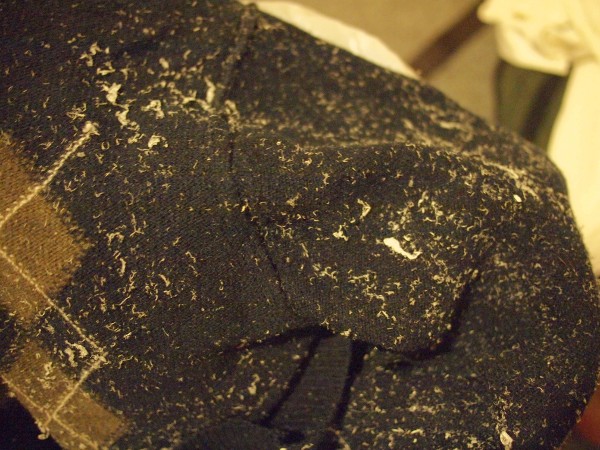At the Mountains of Madness
Having seen both the Gekū and the Naikū, on March 28 I did a fairly ridiculous thing. In fact, I wrote it on my schedule as "do a fairly ridiculous thing", and that's what happened -- only, it was much more eventful, and more unusual, than I could have expected. Now, once again to explain why I did this I will need a fairly long exposition, so be prepared for a wall of text.
A Little Backstory
NOTE: This is a bit of medieval history that explains why I took this trip, but it's not necessary for you to read at all
My concept for March 28 was to walk from the Naikū to an auxiliary miya of the Naiku called Izawa-no-miya伊雑宮, which unlike any of the other miya at Naikū actually lies outside the city of Ise, in a farming village on the other side of the mountains. The traditional story is that Yamatohime-no-mikoto, daughter of Emperor Suinin (29 BCE–70 CE), left Ise to search for a suitable place to harvest food for Amaterasu, and eventually founded this miya, which enshrines Amaterasu, as a base for rice planting in the area. Izawa-no-miya is known to have been Koutai-jingū (Naikū) property and an important site for Amaterasu as early as 804, when it was listed in the Koutai-jingū Gishiki-chou as the "Distant Miya of Amaterasu". In 1181, Izawa-no-miya was sacked in a civil war and had its structures smashed and treasures robbed.
Izawa-no-miya has some duties to the Jingū and minor festivals. Annually in June a sacred rice planting ceremony occurs, and there is an old legend that seven sharks once swam upstream during this ceremony and approached the miya, so the day of the ceremony is considered a bad day to go fishing. In 2006 a ceremony called Okihiki occurred here in which trees were felled for the 2013 Jingū Shikinen Sengū神宮式年遷宮, but it will not again occur until 2026.
This was the story of Izawa-no-miya until the 17th century. In that century a very complicated thing happened, a Shinto theological dispute the likes of which would not be seen again until the modern era. It is so complex that even the Japanese Wikipedia article on the miya, which as I said goes into an inordinate amount of detail, does not really seem to grasp the full extent of the situation. To figure out the full details for myself I took an expensive trip to one of Japan's older universities and, scanning through old documents in the basement like Gandalf, attempted to read a very scholarly and difficult work on the subject by Sadao Iwada岩田貞雄 from Kokugakuin University. Here, as far as I was able to figure out, is the true story.
As an auxiliary miya to the Naikū, medieval Izawa was run by a high level ritualist called a Kanbe and protected by a bunch of shrine workers, vassals really, called Jinin, who had a good amount of influence in the surrounding territory of Isobe. But medieval tumult caused the Jingu to lose control over miya territory, and soon warlords were occupying the area. The disaffected Jinin took up the banner for the miya and began telling the world about its ancient and unique links to the Jingū, but with a twist. Rather than the standard foundation story I have already related, which can be found on several different Japanese websites, they told a totally different story which I believe I am the first to convey to a general audience.
Izawa-no-miya produced about a dozen documents over the years 1640-1690 to explain that it was not just an auxiliary miya but in fact the esoteric, hidden, and most spiritual part of the Naikū. In one petition to Jingū authorities dated August 1648, they write, "Izawa-no-Miya is called one of the Three Miya of Ise with the Naikū and Gekū, a hidden [untranslatable, "place of the way"] in the innermost reaches of the Naikū."
According to Dr. Iwada, the scholar I am poorly summarizing and a former employee of Izawa-no-miya, we have one Uneme Nagano to thank for this theory. Born in 1616, he was trained in Buddhism and Confucianism, becoming an idiosyncratic teacher while allegedly authoring this large series of books. The bakufu believed that he also received assistance from an influential monk of the time called Chouon.
The most famous of these documents, insofar as anything about this dispute is known to anyone, is called the Sendai Kuji Honki Taiseikyou 先代旧事本紀大成経 and purports to be nothing less than a previously unknown history of ancient Japan. Unlike the other evidences, this epic, 72-book document astounded the Edo period intellectual world when it was printed and became widely discussed. There are two principal focuses of the Taiseikyo. The first is new characterization of Prince Shotoku, a fascinating, heroic figure who established Buddhism in Japan. According to the Taiseikyo, Prince Shotoku was not just a Buddhist but harmonized Buddhism, Shinto and Confucianism.
The second focus of the Taiseikyo is securing Izawa-no-Miya's place in the Jingū. It sets out the theory in full: the Gekū represents Heaven, while the Naikū represents Earth: but within the Naikū lies Izawa, which represents Kami and is the true abode of Amaterasu.
I feel this theory does not work quite right, for the Gekū (outer miya) is dedicated to Amaterasu's help mate, while the Naikū (inner miya) is for Amaterasu herself. I feel like it would make more sense for the traveler to go from Earth to Heaven rather than the other way around.
However, besides this apparent mistake the geography of the theory appeals to me considerably. To reach Izawa-no-miya from the Naikū one must pass through the mountain and come out on the other side. The miya is not placed at the top of the mountain, which would be rather unusual for a shrine, but on the other side of the mountain entirely. The pilgrim must enter and leave the liminality of the mountain hike before coming face to face with Amaterasu, who is not forgotten at the top of the mountain, but hidden in the midst of a small village.
In 1681 the Edo government concluded that the Taiseikyo and other documents were forgeries, but Uneme refused to stand down. Instead, he published another book with Chouon asserting that no matter what anyone said the Taiseikyo was a real document. This book was completely destroyed by the government who proceeded to ban any discussion of the Kujiki, a ban that remained in place for over 120 years. Uneme and his family were exiled to a distant part of Japan and died there.
But his theology had lasting influence. The early modern moral syncretism, Suika Shintō, was influenced by the theory. The Hitsuki Shinji quotes the Taiseikyo. The author of Ise-Hakusan Do, which I outlined earlier, also refers to Izawa-no-miya as the hidden third shrine of Ise. But, like me, he thinks that one can only see the miya in its higher aspects after having already visited the Gekū and Naikū. The "innermost point" of Naikū is literally outside of the structure of Ise itself, but it is dependent on this structure. Thus one leaves the city of Ise without leaving the structure of Jingu, and after visiting this miya, one may return to the world and find Jingū in every shrine.
And I'm Off
On Google Maps, viewed from the comfort of my apartment, Izawa-no-miya was a 5-hour walk into the deep mountains. As far as I could tell nobody had ever walked there from Jingū in the past century or so, but that wasn't stopping me, the fearless Westerner. It was a slow walk, mostly down paved roads where I'd be seeing an occasional car. There's be a little hike through the woods, and then I'd be back on the highway for a leisurely stroll into the neighboring city of Shima.
What I didn't realize was that this walk would drive me insane.
To lighten my load, I put my laundry in a bag with two thick books I judged I wasn't going to read while hiking, and stuffed it into a closet at Kazami. Then I visited Tsukuyomi-no-miya, as described on the previous page, prayed for safe passage at Naiku (which was much quieter in the morning), and set off on the road leading out of the Naiku parking lot into the wild.

For a kilometer past Naiku, as the road wound into the mountains, I could only think about how uneventful this was going to be. I'd walk for five hours, get to Izawa-no-miya, and take the train back. What was I expecting to achieve?
I walked across a little stone bridge. A car passed by. I walked and walked, and looked at my iPad, which had no reception by now but could still show me GPS and a fuzzy piece of the Google map. I came to a clearing where someone had planted a line of trees in a really unnatural formation.
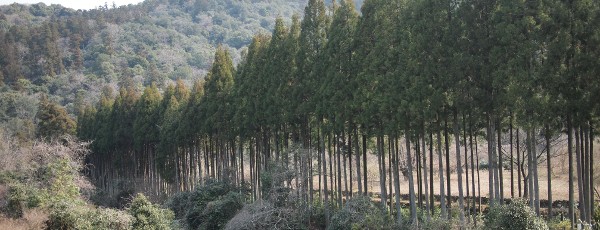
And I kept on walking.
About three kilometers in, over an hour after I had left Naiku, I realized that I really was in the middle of nowhere. It was just a road, and the occasional clearing, and every once in a while on that clearing, across the river, I'd see a human figure tending to crops. But if a bear or dog leaped out at me, who would protect me? And what if one of those farmers was nuts and attacked foreigners with an axe?
I was alone in the mountains. It was not a happy feeling.

After obsessively checking my iPad for a while, I found that I was soon coming up on a kouminkan公民館, a community center kind of building. I did not know why there was one of these in the middle of the mountains. It actually felt kind of creepy, alongside all the other creepy things I was imagining in the woods. But I decided to stop there and have lunch. Arriving at the kouminkan, I played some music so that I wouldn't feel so alone. Soon, I turned it off. Inside there were photos of some people who had slept over in the woods. Otherwise, it was perfectly empty.
I crossed the paths of about three or four people farming in the valley, but nobody displayed any curiosity about me. It was as if they'd rather I didn't make too much of a scene.
Finally, 20 minutes past the kouminkan, I found the place I was supposed to turn to get up the mountain and to the other road. This was what I had been dreading for a while, seeing that the roads branching off of the main one were clearly not paved, and I was not going to be hiking up a little hill trail but was seriously taking a dirt path used only for putting out forest fires and dumping dead bodies. When I got to the entrance, though, my heart sank.
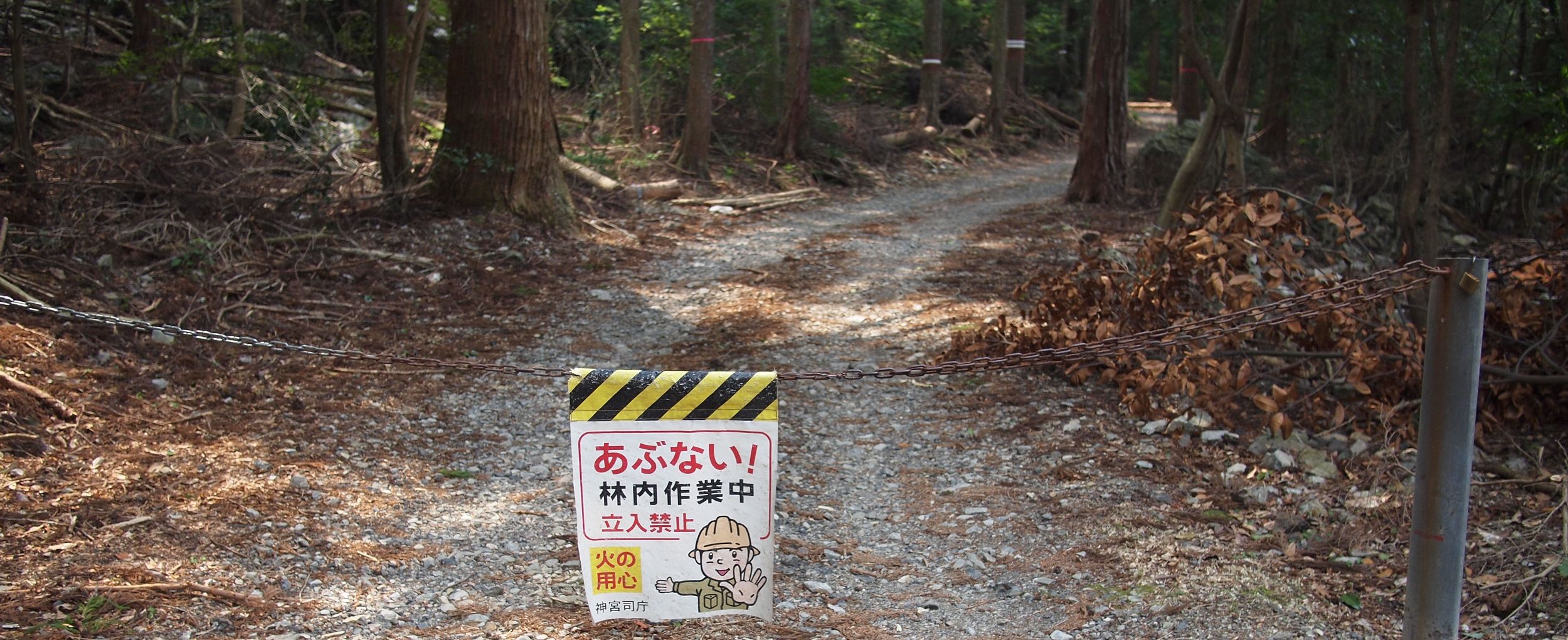
Danger!
Forest Undergoing Repairs [?... see later]
NO ENTRY
Jingū Office[By the way... WTF? Does the Jingū own this entire mountain?]
This was it: a crossroads. I started to turn back, then turned around again. Was this some kind of test? Only the bravest souls could get to Izawa-no-miya on foot? That's what this was, wasn't it!
I hopped the fence and started up the mountain. This was a damn fool thing to do, I'm really glad I have my life destroyed by what happened next, and I would not recommend anyone enter an off-limits forest in Japan alone. Just do not do this. Always have several Japanese friends on hand before hopping any fences, and don't trespass on dangerous land, or land that people might be actively using. If you died I would not forgive you. DON'T.
It was on Google Maps, right? The map shows a trail around the mountain and to the other side, so just follow the map, right? Ahahahah!
I started walking up the trail, which looked like this photo. Soon I was nearing the peak of the mountain, but GPS showed me that I had quite a bit of walking to do. Being near the top made me feel a bit less scared, and I rounded the twists and turns with ease, even trying to make a jog out of it.
I felt at peace, running through a quiet forest, where I was sure not to meet anyone.
Then I saw the most frightening thing I have ever seen in my life.
There was a white van in the middle of the trail.
Oh, Shit.
The van was open. Its owner had clearly left it there a very short time ago. Contents were hanging out. There was a long rope. There were some blankets. There were strange metal devices I could not name.
Oh, shit. Oh dear God. Game over, man.
Visions of horror films flashed through my head.
Well.
The truck was parked along the winding forest trail, with a steep slope above and below it. I didn't hear any sounds. The owner might be somewhere else on the mountain entirely.
Irrationally, I thought I might be able to just sneak around it, as if the owner wouldn't bump into me eventually. I mean, this was totally ridiculous, but I had just walked for three and a half hours. I was bursting with adrenalin. I needed to get across this mountain.
Quietly, I started to inch forward, towards the truck.
That's when I heard a rustling above me.
I jerked my head up, and saw a man strapping something to a tree.
It was a forestry worker, about 50 meters away. He was marking the trees, or something, and didn't notice me. His open truck was full of forestry equipment. Obviously, he couldn't have expected a random idiot to be trespassing on foot in a mountain forest.
He shouted something in Kansai-ben, and I realized there was another guy there also marking trees. Two sets of eyes that could fall on me at any moment.
I started pacing back and forth. If they noticed me, they would probably come and grab me. If they grabbed me, they'd want me off the mountain. Being noticed and removed was probably an 8 out of 10 chance. What if they didn't drop me in a good place? They had every right to take me to the police station, and the chance they would was roughly 50-50, given how suspicious my actions were. (By the way, in case you didn't realize, this is fiction. I didn't hop the fence and have never broken Japanese law.) Would the police believe I just wanted to hike to a little known auxiliary miya of the Jingu? This would be the end of my employment in Japan. I would go home to America and pick my nose for a living.
I calculated the probabilities of all this happening... without leaving the line of sight of the workers. I was pacing back and forth frantically on the trail, crunching sticks under my feet. "Oh shit," I whispered to myself. "Oh God oh Hell oh shit." Oblivious, for the moment, they continued yelling back and forth to each other in Kansai-ben.
I started sneaking towards the truck again, and then I realized that this was totally crazy. I had gone nuts. I snapped to... something. I don't think it was sense, but I realized how close I was to being kicked out of the country, turned, rounded the corner, and started running for dear life.
I basically ran downhill for 10 minutes all the way back to the fence, which I then hopped again. No witnesses. I was safe. I was free.
Looking at this photo now, I realize that the real meaning of the sign that I had hopped over was, "Men At Work In Forest".
Failure
What did this all mean? Why did I walk all morning just to fail? Were those forestry workers another test, and had I failed... or had I passed, by displaying a modicum of common sense from my lizard brain? Well, it didn't matter. The important thing was that I was alive and safe, and I knew the road back.
My feet hurt. My feet ached very much, actually. They ache just thinking about this now. I had just walked 10 kilometers and run down a rocky forest trail without any sort of appropriate footgear. I wanted very much to stop walking.
A car came by. I stuck out my thumb. No reaction-- it whizzed past. Well, I already knew Japanese drivers wouldn't stop a moving car for hitchhikers, especially not on a one-lane road. I had learned that when I hitchhiked the previous day.
Nevertheless, I had 10km to walk. I wanted very much to try.
A truck went past. I stuck out my thumb, nothing. I walked ten minutes. A car went past. I stuck out my thumb, nothing. I tried not to think bad thoughts about the driver as it left my field of sight. I walked twenty minutes. A car came down the road. I wildly stuck out my thumb, against all hope.
The car stopped. I got in. "Thank you thank you thank you," I said in Japanese. "Please take me to Ise Station."
"What're you doing out here in the middle of nowhere?" asked the driver.
"Oh God," I sighed. "I was hiking to a place called Izawa-no-miya, but it looks like this was the wrong road..."
"No way," said the driver. "Me too!"
Ant
As we got to the point I would have reached on the other side of the mountain, I realized it was right at the entrance of a very long tunnel. At the other end of the tunnel was several kilometers of highway, with no footpath. Walking through the tunnel and down the highway would have been just as stressful as the mountain, much more dangerous, and even more likely to get me arrested. So, I'm glad for the divine intervention.
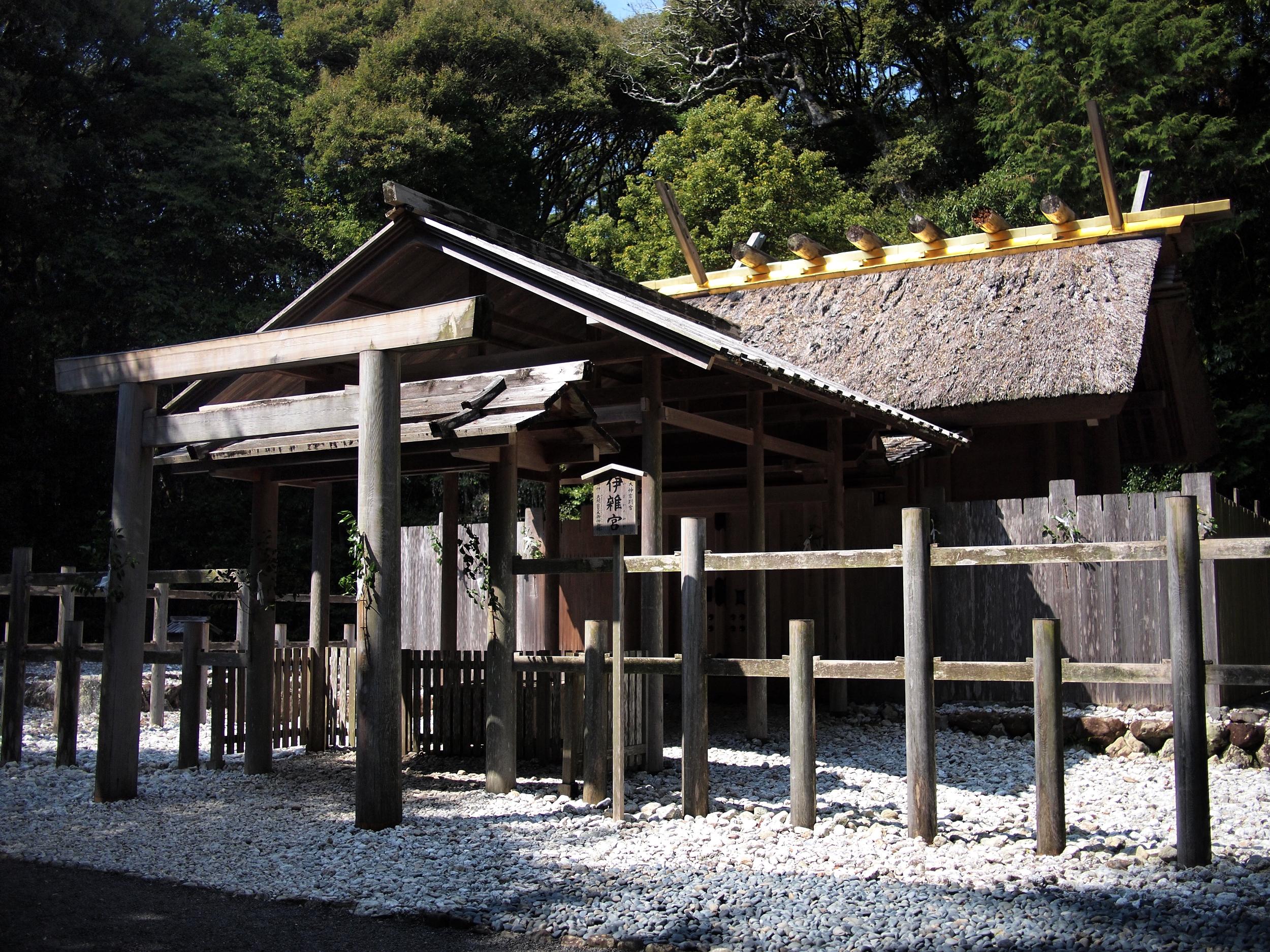
The driver called himself Ari, that is, Ant. As shown in the picture above, we went to Izawa-no-miya together. He took me to various unusual shrines near Ise which only he knew about, and which he was visiting that very day for some weird reason. He was as strange as me, but I eventually became more neurotic than him, because I was a passenger riding in a car with a total stranger, and he would sometimes say really weird things that I couldn't understand the nuance of. (I imagine I would also say weird things if I were taking trips to unusual places around Ise.) I'm not going to quote any of these because, in the end, he was just a nice guy who was a bit socially awkward and wanted to take me places, so I have no interest in slandering him. From his perspective, he was very nice to me and I didn't let him stop for lunch, even at 4PM, so I was a bit of a dick hitchhiker. Since he didn't speak English, though, the language barrier started to build up on my side. I didn't know how to ask him whether he was an axe murderer in a polite, acceptable way. Okay, really I can think of some things now, but I was pretty panicked. There was a lot of silence in the car.
The last place we visited to was a remote shrine called Izawa Jinja伊射波神社. The relationship to Izawa-no-miya is unclear, and it seems that they may have been linked in some way in the distant past. This shrine is located nowhere near Izawa-no-miya, but it is in a very strange place: it can be accessed only by hiking through thick wilderness for 20 minutes, or by taking a tiny thicket trail up from a rocky beach which appears to be virtually inaccessible. This may be unique in all Japan. I summoned up all my courage to get out of the car alone with Ant at a remote stop near the seashore, but Izawa Jinja could not be reached from our spot of seashore. Large rocks were in the way.
We got back in the car. "I know a better way to get there," offered Ant.
"Actually," I said, "I'm very tired. Drop me at the nearest train station." My neurosis, based solely on his odd statements to me and the ever-reliable Google Maps, was telling me that he was lying, and just wanted an excuse to drive me somewhere remote and kill me.
But what he actually did was drop me at the train station, and probably go to a restaurant and finally get a bite to eat. Poor guy. I thanked him again for the wonderful day, but I did not give him my contact information, and I didn't ask for his. I hope he is doing well and doesn't think too badly of me. The mystery of Izawa Jinja will have to wait for next time.
I did not feel relieved until I made it back to Kazami in one piece. I dumped the contents of my laundry bag into the washing machine. I then poured out my unbelievable day to my two new friends.
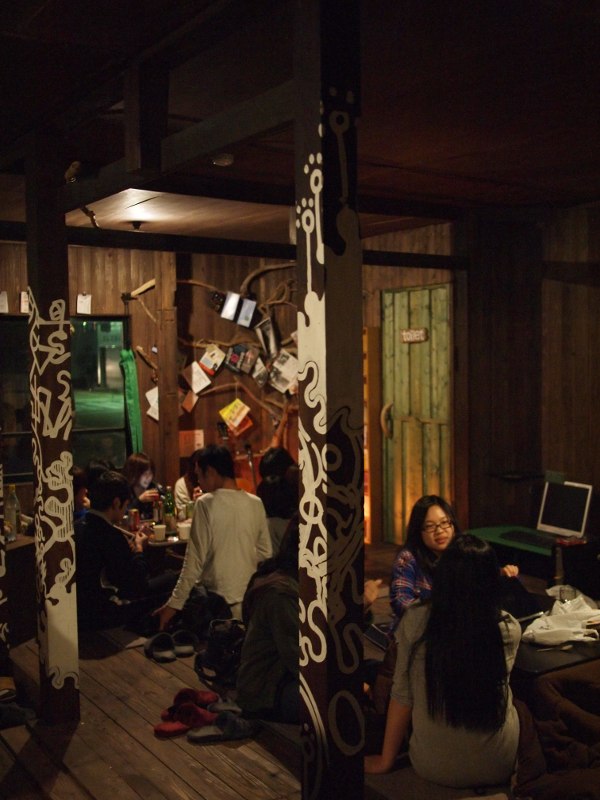
What happened to me on this day seems to have metaphorical meanings behind every action I actually took.
- The trip that I took was not something that a sensible Japanese person would do.
- However, rather than pushing myself too far, I did turn back eventually.
- In a stunning coincidence, I met a random Japanese guy who wanted to help me achieve my quest.
- But I was unable to connect with him on an emotional level due to the language barrier.
After running through this with my friends, I checked the washing machine.
Did you notice what I did? I mentioned it, but I bet you didn't.
I had dumped the entire contents of my bag into the machine -- including the two books. The washing machine had done its job and reduced the books to a huge vat of pulp, with my clothes floating in the middle, covered in wet flakes of paper.
I spent the rest of the evening trying to beat the pulp out of my clothes, and I am afraid little specks of paper are probably still floating around Kazami somewhere. Well, as I've said before, this guest house is amazing and you need to check it out. Tell them I'm sorry!
